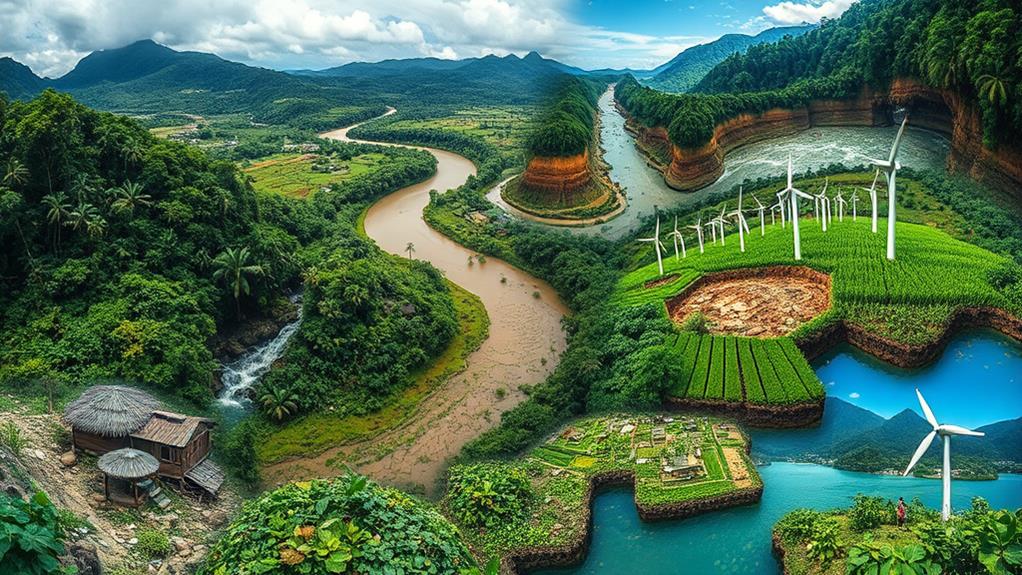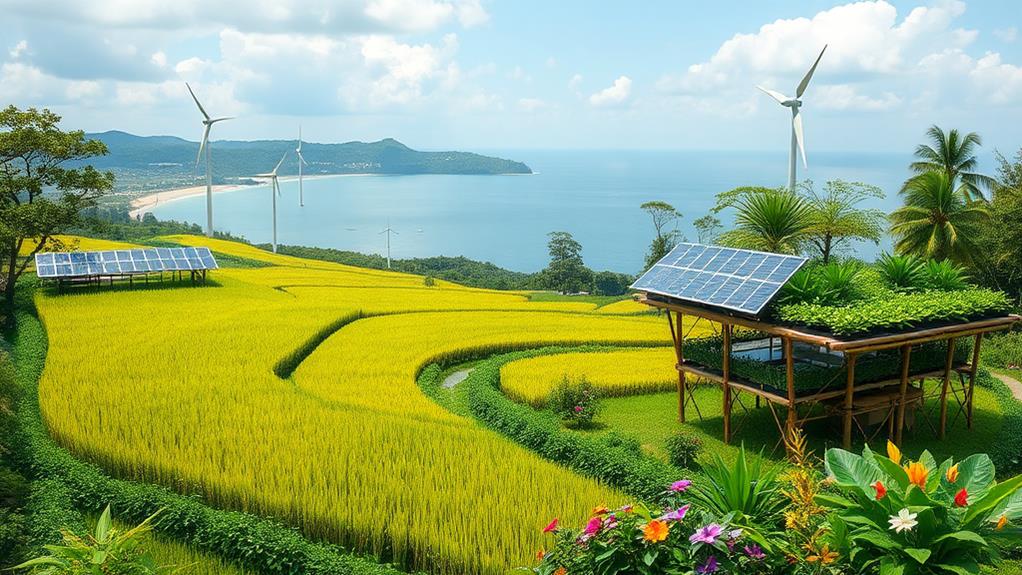Creating a sustainable future for Philippine natural resources and industries is essential to tackle issues like pollution, deforestation, and reliance on fossil fuels. Currently, 70% of electricity in the Philippines comes from fossil fuels, which contributes to pollution. There is a pressing need to shift towards renewable energy sources such as solar, wind, and hydroelectric power to reduce the country’s carbon footprint. By keeping up with the latest energy industry trends, the Philippines can invest in sustainable infrastructure and technology to meet its energy needs while preserving its natural resources for future generations. This shift will not only benefit the environment but also create a more stable and independent energy supply for the country.
Plastic waste is also a major problem, harming marine life and ecosystems.
To address these challenges, you can support important initiatives. The Renewable Energy Act promotes the use of renewable energy sources like solar and wind. This can help reduce the country's dependence on fossil fuels.
The National Greening Program focuses on planting trees and restoring forests, which can combat deforestation and improve air quality.
Community involvement and education are crucial. Engaging local communities can lead to better environmental practices. Teaching people about the importance of protecting natural resources fosters a sense of responsibility.
By focusing on smart innovations and teamwork, we can create a balanced approach to managing resources. For example, using technologies that improve energy efficiency and reduce waste can make a significant difference.
Find out more about these strategies and how you can take part in making a positive impact.
Current Sustainability Challenges

Addressing the sustainability challenges in the Philippines is essential for protecting the environment. The country ranks 158th out of 180 in the Environmental Performance Index, highlighting issues like poor waste management and deforestation.
Each year, the Philippines produces 2.7 million tons of plastic waste, which harms marine life and contributes to plastic pollution. Air quality in cities is also a problem, with fine particulate matter exceeding WHO's safety standards, affecting many people's health.
From 2010 to 2021, the country lost 300,000 hectares of natural forest, worsening environmental damage and increasing greenhouse gas emissions.
About 70% of electricity in the Philippines comes from fossil fuels, indicating a heavy dependence on non-renewable energy. This reliance raises greenhouse gas emissions and slows down the shift to renewable energy sources.
Therefore, it's crucial to develop effective waste management strategies and promote sustainable practices to protect the environment and improve the future for the Philippines.
Policy Initiatives for Sustainability
Policy initiatives are essential for guiding the Philippines toward a sustainable future. The Renewable Energy Act, passed in 2008, aims for 15% of energy to come from renewable sources by 2030. This law helps reduce the country's dependence on fossil fuels.
Another important law is the Climate Change Act, enacted in 2009, which focuses on lowering carbon emissions. This act also encourages local governments to create their own climate action plans.
In addition, the National Greening Program, started in 2011, aims to reforest 1.5 million hectares of land. This program helps protect biodiversity and manage natural resources wisely.
These initiatives support the Philippine Strategy for Sustainable Development (PSSD), which seeks to combine economic growth with environmental care.
Collaboration between the public and private sectors is crucial in these policies. This teamwork fosters innovation and creates green jobs.
By focusing on both environmental protection and economic growth, the Philippines can mitigate climate change effects and build a resilient future.
Innovations in Sustainable Practices

The Philippines is making great strides in sustainable practices. Innovative technologies like solar panels and rainwater harvesting systems are being used in homes to lower carbon emissions. These methods help save energy and protect the environment.
The National Greening Program is working on reforestation. This program aims to restore damaged ecosystems and improve biodiversity throughout the country.
Additionally, the Meloy Fund provides $17.5 million to help promote sustainable fishing. This effort ensures that communities have enough food while also protecting ocean resources.
Some key innovations include:
- Smart home automation technologies that help manage renewable energy and improve energy use.
- Community-led projects such as the bamboo economy in Mindanao, which creates jobs and protects natural resources.
- Environmentally friendly fishing techniques that support both the economy and marine life.
- Reforestation efforts that fight climate change and restore important habitats.
These actions show the Philippines' commitment to developing sustainable solutions for its resources and industries.
Community Engagement and Education
Community engagement is essential for promoting sustainable practices in the Philippines. Environmental education and local participation create a culture that values biodiversity conservation. For example, community-led projects like mangrove and coral reef restoration help improve local ecosystems.
Partnerships between local governments and communities have successfully implemented the National Greening Program, which aims to reforest 1.5 million hectares of land. Educational campaigns that teach traditional farming techniques, such as crop rotation and using natural fertilizers, also support both the environment and community empowerment.
The table below shows the impact of these community engagement initiatives:
| Initiative | Impact |
|---|---|
| Grassroots Biodiversity Projects | Improved ecosystem health |
| National Greening Program | Reforestation of 1.5 million hectares |
| Sustainable Agriculture Campaigns | Adoption of eco-friendly practices |
| Public Advocacy for Sustainability | 88.7% support for environmental measures |
Your involvement in these initiatives shows a strong commitment to sustainability, contributing to a better future for the Philippines.
Future Directions for Natural Resources

The future of natural resources in the Philippines needs a clear plan.
The Philippine government should focus on sustainable practices that help nature and support economic growth. This means creating strong rules and policies that fight climate change and encourage clean energy.
Here are some key actions to take:
- Include Environmental Impact Assessments (EIA) in all development projects. This ensures that any new project considers its effects on the environment.
- Encourage community involvement in managing natural resources. Local people often have valuable knowledge and interest in protecting their environment.
- Create more protected areas to restore habitats and save unique plants and animals. This helps maintain biodiversity.
- Develop programs that include family planning and population concerns. Managing population growth is essential for sustainable resource use.
Questions and Answers
How Can We Achieve Sustainability in the Philippines?
To achieve sustainability in the Philippines, we must focus on several key areas. First, we need to embrace renewable energy. This can be done by investing in solar panels and wind turbines, which provide clean power without harming the environment.
Second, we should implement effective waste management. This includes recycling programs and composting to reduce the amount of trash that ends up in landfills. For example, separating plastics, metals, and organics can help minimize waste.
Next, promoting eco-tourism is essential. This means attracting visitors to natural areas while ensuring that they do not harm the environment. For instance, guided tours in protected forests can educate tourists and generate income for local communities.
Additionally, engaging in sustainable agriculture is important. Farmers can use organic farming practices that avoid harmful chemicals and promote biodiversity. Crop rotation and planting native species can help restore soil health.
We also need to advocate for policies that support environmental protection. This could include laws that limit pollution and encourage conservation efforts.
Finally, fostering community involvement through environmental education is crucial. Schools can teach students about the importance of taking care of the planet, while local workshops can promote responsible consumption practices, such as using reusable bags and reducing plastic use.
What Is the Philippine Strategy for Sustainable Development?
The Philippine Strategy for Sustainable Development focuses on three main areas: sustainable tourism, renewable energy, and waste management.
Sustainable tourism encourages visitors to enjoy natural and cultural resources while protecting the environment. For example, eco-tours showcase local wildlife and landscapes without harming them.
Renewable energy promotes energy sources that do not deplete natural resources. A common example is solar power, which uses sunlight to generate electricity, reducing dependence on fossil fuels.
Waste management involves practices to reduce, reuse, and recycle materials. For instance, community clean-up drives help keep public spaces tidy while teaching people about proper waste disposal.
What Is the Goal 4 of Sustainable Development in the Philippines?
Goal 4 in the Philippines focuses on sustainable education. This means teaching people about the environment and getting them involved in their communities. For example, schools may include lessons on renewable energy sources like solar and wind power.
The goal also promotes effective waste management. This includes programs that teach people how to recycle and reduce trash. Another important aspect is biodiversity conservation, which protects different plant and animal species.
Additionally, the goal encourages ecological restoration. This involves repairing damaged environments, such as replanting trees in deforested areas. Lastly, it supports the use of green technology, which helps communities adapt to climate change. Overall, Goal 4 aims to create a more informed and environmentally responsible society.
What Are the Natural Resources of the Philippines and Its Industries?
The Philippines has many natural resources, including minerals, agricultural products, and fish. Mineral extraction includes resources like gold, copper, and nickel. The country also has a strong agricultural sector that produces rice, corn, and sugarcane. Additionally, the fishing industry supplies many types of seafood, providing food and jobs for many people.
Sustainable practices are important for the country's future. Forestry management helps protect forests and wildlife. Renewable energy initiatives, like solar and wind power, aim to reduce reliance on fossil fuels. Finally, biodiversity conservation ensures that various species and ecosystems are preserved.